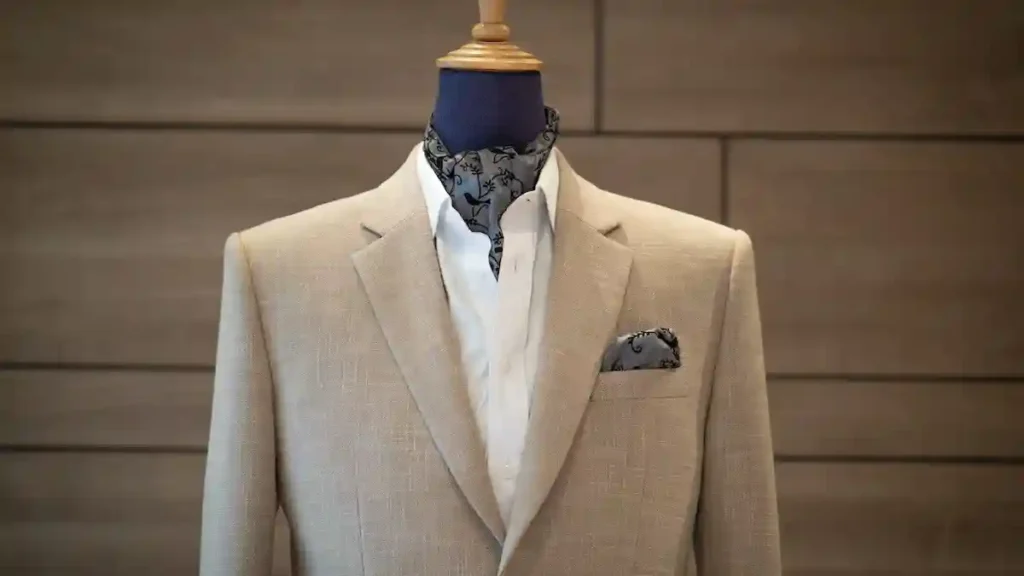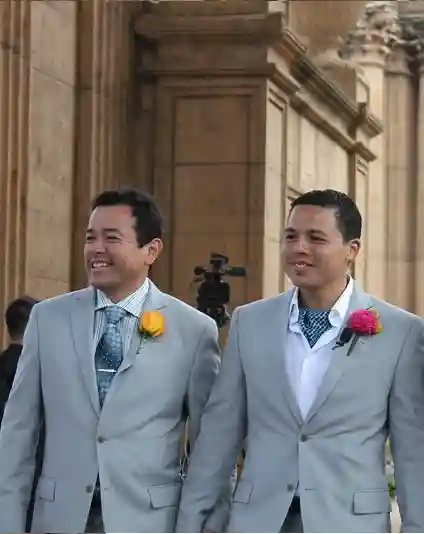Want to look sharp? Learn how to tie an ascot today. This guide shows you easy steps. You will master this skill fast.
An ascot makes any outfit better. It adds class to your look. Many men skip this accessory. They think it’s too hard. But it’s simple once you know the steps.
What Is an Ascot?

An ascot is special neckwear. It sits around your neck like a scarf. But it looks more formal than a scarf. It’s wider than a regular tie.
The fabric is soft. Most ascots use silk. Some use cotton or linen. The ends are wide and flat.
Basic Facts About Ascots:
- They come from England
- Rich men wore them to horse races
- They work for day and night events
- They feel comfortable around your neck
- They cost less than fancy ties
Why Learn How to Tie an Ascot?
Smart men know how to tie an ascot for good reasons:
- You stand out: Most men don’t wear them
- They’re comfortable: No tight knots around your throat
- Works anywhere: Perfect for weddings and parties
- Easy to wear: Takes two minutes to put on
- Looks expensive: People think you spent big money
- Never goes out of style: Classic look that lasts
Ascot vs Regular Tie: Key Differences

Regular ties and ascots are not the same. Here’s how they differ:
Regular Tie:
- Narrow width
- Hard knot at throat
- Same length on both sides
- Works only with suits
- Takes practice to tie right
Ascot:
- Wide ends
- Soft drape around neck
- One end longer than other
- Works with many outfits
- Easy to put on
What You Need Before Starting
Gather these items before you learn how to tie an ascot:
Must-Have Items:
- One good ascot
- Clean mirror
- Proper lighting
- Dress shirt with collar
- About five minutes of time
Nice-to-Have Items:
- Ascot pin for fancy events
- Small comb for neat hair
- Good cologne
- Matching pocket square
Step 1: Pick the Right Ascot
The first step in how to tie an ascot is choosing well. Not all ascots work the same way.
Best Colors for Beginners:
- Navy blue: Goes with everything
- Gray: Safe choice for any event
- Burgundy: Rich look that impresses
- Cream: Perfect for summer events
- Black: Only for evening parties
Fabric Types:
- Silk: Best choice for special events
- Cotton: Good for daily wear
- Linen: Perfect when it’s hot outside
- Polyester: Cheap but looks fake
Step 2: Prepare Your Shirt
Put on your dress shirt first. Leave the top button open. This gives room for the ascot.
Flip your collar up. This helps you work with the ascot. You’ll fold it down later.
Make sure your shirt fits right. A loose collar makes the ascot look sloppy.
Step 3: Position the Ascot
Place the ascot around your neck. One end should hang longer than the other.
The right side should be about six inches longer. This gives you enough fabric to work with.
Don’t make it too tight. You should breathe easily. But don’t make it too loose either.
Step 4: Cross the Ends
Take the longer end. Cross it over the shorter end. Do this at your throat level.
Keep the cross point in the center. This looks best when you’re done.
Hold both ends gently. Don’t let them slip while you work.
Step 5: Make the Loop
Bring the long end up behind your neck. Thread it through the loop you made.
Pull it through carefully. Don’t twist the fabric. Keep it smooth and flat.
The end should come out clean. No bunching or wrinkles.
Step 6: Adjust and Tuck
Now comes the final step. Tuck both ends into your shirt opening.
Smooth out any wrinkles. Make sure both sides look even.
Adjust the tightness. It should feel snug but not tight.
Fold your collar down. Check yourself in the mirror.
Easy Method: Simple Drape Style
Some men prefer an easier way to tie an ascot. This method takes less time.
Quick Steps:
- Put ascot around neck evenly
- Cross ends loosely at throat
- Tuck both ends into shirt
- Smooth and adjust
- Done in one minute
This style works great for casual events. It looks relaxed but still classy.
Common Mistakes to Avoid
Many men make these errors when learning how to tie an ascot:
Tying Mistakes:
- Making it too tight: This hurts your neck
- Uneven sides: Makes you look messy
- Wrong position: Too high or too low looks bad
- Rushing the process: Take your time
- Ignoring wrinkles: Smooth fabric looks better
Style Mistakes:
- Wrong colors: Don’t clash with your shirt
- Bad occasions: Casual ascots at formal events
- Poor fabric care: Wrinkled ascots look cheap
- No confidence: Wear it like you mean it
Best Occasions for Ascots
Knowing when to wear an ascot matters. Here are perfect times:
Formal Events:
- Weddings in the daytime
- Garden parties
- Art gallery openings
- Charity dinners
- Business launches
Casual Events:
- Weekend brunches
- Casual dates
- Shopping trips
- Coffee meetings
- Friends’ gatherings
Special Occasions:
- Anniversary dinners
- Theater shows
- Wine tastings
- Country club events
- Holiday parties
Colors That Work Best
Choose colors that match your style. Here are safe choices:
Fair Skin:
- Light blue ascots
- Soft gray options
- Cream colors
- Pale yellow shades
- Light green tones
Dark Skin:
- Rich burgundy
- Deep navy blue
- Bright white
- Gold colors
- Purple shades
Medium Skin:
- Most colors work
- Try bold choices
- Earth tones look great
- Jewel colors shine
Patterns and Designs
Start with solid colors. Once you feel confident, try patterns.
Beginner Patterns:
- Thin stripes: Easy to match
- Small dots: Classic look
- Simple checks: Not too busy
- Subtle paisley: Adds interest
Advanced Patterns:
- Large florals: For confident men
- Bold geometric: Makes statements
- Mixed patterns: Very tricky
- Bright colors: Needs skill
Caring for Your Ascot
Take good care of your ascots. They’ll last longer and look better.
Daily Care:
- Hang it up after wearing
- Let it air dry completely
- Check for stains right away
- Handle fabric gently
- Store in cool, dry places
Cleaning Tips:
- Read the care label first
- Use gentle soap for hand washing
- Never wring or twist wet fabric
- Lay flat to dry completely
- Iron on low heat if needed
Storage Rules:
- Fold with tissue paper
- Keep away from direct sunlight
- Use cedar blocks for moths
- Check stored ascots monthly
- Replace damaged ones quickly
Troubleshooting Problems
Sometimes things go wrong. Here’s how to fix common issues:
Keeps Slipping:
- Tighten it slightly
- Use an ascot pin
- Choose textured fabric
- Check your shirt collar
Looks Uneven:
- Start over completely
- Measure the lengths again
- Use a mirror to check
- Ask someone to help
Feels Uncomfortable:
- Loosen it a bit
- Try softer fabric
- Check the size
- Practice more often
Building Confidence
Wearing an ascot takes confidence. Here’s how to build it:
Start Small:
- Wear it at home first
- Try it with casual clothes
- Practice in front of mirror
- Get used to the feel
Get Feedback:
- Ask friends what they think
- Notice how people react
- Take photos to see how it looks
- Adjust based on responses
Practice Often:
- Wear it regularly
- Try different styles
- Experiment with colors
- Make it part of your routine
Budget-Friendly Options
You don’t need to spend lots of money. Here are smart shopping tips:
Where to Shop:
- Department stores: Good selection
- Online retailers: Best prices
- Vintage shops: Unique finds
- Discount stores: Budget options
- Estate sales: Hidden gems
What to Look For:
- Good fabric quality: Will last longer
- Proper size: Fits your neck right
- Classic colors: Work with more outfits
- Care instructions: Easy to maintain
- Return policy: In case it doesn’t work
Advanced Techniques
Once you master basic how to tie an ascot skills, try these:
The Puff Method:
- Creates more volume around neck
- Looks very formal and elegant
- Needs practice to get right
- Perfect for special events
The Pin Style:
- Uses decorative pins for security
- Adds sparkle to your look
- Works well with silk ascots
- Shows attention to detail
The Layered Look:
- Combines ascot with vest
- Very sophisticated appearance
- Best for formal occasions
- Requires careful color matching
Modern Style Tips
Today’s men wear ascots differently than before. Here are current trends:
Casual Mixing:
- Wear with polo shirts
- Try with casual jackets
- Mix with jeans for weekend looks
- Add to simple t-shirts
Color Trends:
- Earth tones are popular
- Bright colors make statements
- Metallic threads add shine
- Vintage patterns are back
Seasonal Choices:
- Spring: Light colors and florals
- Summer: Linen and cotton fabrics
- Fall: Rich burgundy and gold
- Winter: Deep colors and silk
Final Tips for Success
Remember these key points as you learn how to tie an ascot:
Practice Makes Perfect:
- Try different methods
- Practice at home first
- Don’t give up if it’s hard
- Each time gets easier
Confidence Is Key:
- Wear it with pride
- Don’t fidget with it
- Act like you always wear one
- Smile and enjoy the compliments
Keep Learning:
- Watch how other men wear them
- Try new colors and patterns
- Experiment with different occasions
- Make it your signature look
Conclusion
Learning how to tie an ascot is simple and worthwhile. Start with basic colors and practice at home. This classic skill makes you stand out at any event. Choose quality fabric and follow the easy steps. Practice builds confidence. Soon you’ll tie ascots naturally. This timeless accessory adds class to your wardrobe without breaking the bank. Master this skill today.






